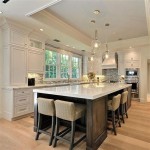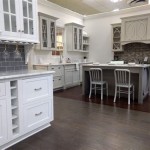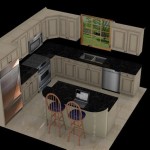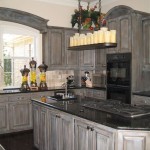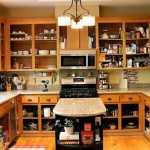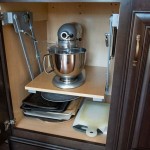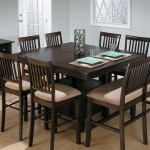Grey Tiles in White Kitchens: A Study in Contrast and Harmony
The pairing of grey tiles with white kitchens represents a popular and enduring design choice in contemporary interior design. This aesthetic transcends fleeting trends, offering a versatile foundation upon which various styles and personal expressions can be built. The inherent neutrality of both grey and white allows for seamless integration with diverse design elements, from rustic farmhouse to sleek modern minimalism. Understanding the nuances of this combination, including the various shades of grey, textures, and tile patterns, is crucial for achieving a balanced and visually appealing kitchen space.
The appeal of this design stems from its inherent contrast. White, often associated with cleanliness, light, and airiness, serves as a blank canvas. Grey, acting as an anchor, introduces depth, sophistication, and a touch of groundedness. This interplay creates visual interest and prevents the kitchen from feeling sterile or overly clinical. The specific effect achieved depends heavily on the chosen shades and textures.
The Psychology of Grey and White: Creating Atmosphere
The psychological impact of color within a space is a critical factor in design considerations. White interiors tend to evoke feelings of calm, clarity, and spaciousness. However, an exclusively white environment can sometimes feel cold or impersonal. This is where grey enters the picture. Grey, a neutral color found between black and white, brings a sense of balance and stability. It can be perceived as sophisticated, elegant, and even calming. The specific shade greatly influences its effect; lighter greys tend to feel more airy and modern, while deeper greys add drama and warmth.
The combination of white and grey creates a harmonious blend of these psychological associations. The white provides the uplifting and spacious feel, while the grey grounds the space and adds a layer of sophistication. This balance is particularly important in the kitchen, a space often used for both practical tasks and social gatherings. A well-designed grey and white kitchen can foster an environment that is both functional and inviting.
Exploring Different Shades of Grey and Their Impact
The spectrum of grey is vast, ranging from the palest silver to the deepest charcoal. Each shade possesses unique characteristics and contributes a distinct atmosphere to the kitchen. Light greys, often referred to as dove grey or cloud grey, emulate the airy quality of white while adding a subtle touch of color and visual interest. These shades work exceptionally well in smaller kitchens, reflecting light and creating an illusion of greater space. They also complement a wide range of other colors, making them a versatile choice.
Mid-tone greys, such as slate grey or steel grey, offer a more pronounced contrast against white cabinetry. These shades lend a sense of sophistication and can be used to create a more dramatic effect. They are particularly effective in larger kitchens, where they can anchor the space without feeling overwhelming. Consider the amount of natural light available when choosing a mid-tone grey; darker shades can absorb light and make a room feel smaller if not properly illuminated.
Dark greys, including charcoal grey and graphite grey, are the boldest option. These shades create a striking contrast against white and can add a significant dose of drama to the kitchen. Dark grey tiles are often used as a focal point, such as a backsplash behind the stove or a striking floor covering. While visually impactful, dark greys require careful consideration of lighting and surrounding elements. They work best in well-lit kitchens with ample natural light or strategically placed artificial lighting to prevent the space from feeling too dark or enclosed.
Tile Types and Patterns: Adding Texture and Visual Interest
Beyond the shade of grey, the type of tile and its pattern play a crucial role in the overall aesthetic of the kitchen. Ceramic tiles are a popular choice for their durability, affordability, and ease of maintenance. Porcelain tiles are even more durable and resistant to moisture, making them ideal for high-traffic areas like the kitchen floor. Natural stone tiles, such as slate or granite, offer a luxurious and textured look, but require more maintenance and can be more expensive.
The choice of tile pattern can also significantly impact the kitchen's style. Subway tiles, arranged in a classic horizontal pattern, are a timeless choice that complements both traditional and modern kitchens. Herringbone patterns, created by arranging rectangular tiles in a zig-zag formation, add a touch of sophistication and visual interest. Geometric patterns, such as hexagons or chevrons, create a more contemporary and dynamic look. For those seeking a rustic or farmhouse aesthetic, textured tiles that mimic the look of brick or wood can add warmth and character.
Grout color is another important consideration. A light grout color, such as white or light grey, will create a seamless look and emphasize the shape of the tiles. A dark grout color, such as charcoal grey or black, will highlight the tile pattern and create a more defined contrast. The choice of grout color should be carefully considered based on the overall design goal and the desired level of visual impact.
Integrating Grey Tiles with White Kitchen Components
The success of a grey and white kitchen lies in its seamless integration of various components, including cabinetry, countertops, hardware, and lighting. White cabinetry, whether painted or laminate, provides the perfect backdrop for grey tiles. The shade of white used should be carefully considered in relation to the chosen grey tile; a warm white might complement a warmer grey, while a cool white might pair better with a cooler grey. The style of the cabinetry, whether traditional, modern, or transitional, will also influence the overall aesthetic.
Countertops provide another opportunity to introduce texture and color. Quartz countertops, known for their durability and non-porous surface, are a popular choice for kitchens. Marble countertops offer a luxurious and elegant look, but require more maintenance. Granite countertops provide a natural and unique pattern, but can be more porous than quartz. The color of the countertop should complement both the grey tiles and the white cabinetry, creating a cohesive and balanced look.
Hardware, such as cabinet pulls and knobs, provides a subtle yet impactful detail. Brushed nickel, chrome, or stainless steel hardware complements the modern aesthetic of a grey and white kitchen. Black or oil-rubbed bronze hardware adds a touch of sophistication and contrast. Brass or gold hardware can introduce warmth and a touch of glamour. The style of the hardware should align with the overall design and the personal preferences of the homeowner.
Lighting is crucial for showcasing the beauty of a grey and white kitchen. Natural light should be maximized whenever possible, as it enhances the colors and makes the space feel more open and airy. Recessed lighting provides general illumination, while pendant lights over the kitchen island or countertops add task lighting and visual interest. Under-cabinet lighting illuminates the countertops and backsplash, highlighting the texture and color of the grey tiles. The color temperature of the lighting should also be considered; warm lighting creates a cozy and inviting atmosphere, while cool lighting provides a more modern and crisp feel.
Specific Applications of Grey Tiles in White Kitchens
The versatility of grey tiles allows for various applications within the white kitchen. Grey tile backsplashes are a common and effective way to introduce color and texture behind the stove or sink. A grey tile backsplash can serve as a focal point, drawing the eye and adding visual interest to the space. The pattern and texture of the tile can be chosen to complement the overall style of the kitchen. For example, a subway tile backsplash in a light grey color can create a classic and timeless look, while a geometric tile backsplash in a darker grey color can add a modern and dynamic touch.
Grey tile flooring is another popular choice for white kitchens. Grey floors provide a grounding element and create a visually appealing contrast against white cabinetry. The shade of grey used for the flooring should be carefully considered in relation to the size of the kitchen; darker greys can make a small kitchen feel smaller, while lighter greys can help to create an illusion of greater space. The texture of the tile can also impact the overall feel of the room; smooth tiles provide a sleek and modern look, while textured tiles add warmth and character.
Grey tile accents can be used to add subtle touches of color and visual interest. Grey tile borders or inlays can be incorporated into the backsplash or flooring to create a unique and custom look. Grey tile niches or shelves can be added to the backsplash to provide storage and display space. These small details can elevate the design and add a personal touch to the kitchen.
Maintaining Grey Tiles in a White Kitchen Environment
Maintaining the aesthetic appeal of grey tiles in a white kitchen requires consistent cleaning and care. Regular cleaning with a mild detergent and water is essential to remove dirt, grime, and spills. Harsh chemicals and abrasive cleaners should be avoided, as they can damage the tile surface and grout. Grout lines should be cleaned regularly to prevent staining and discoloration. A grout brush and a solution of baking soda and water can be used to scrub the grout lines clean.
Sealing the grout is also important to protect it from moisture and stains. A grout sealant should be applied after cleaning and every few years to maintain its effectiveness. Natural stone tiles require special care and should be cleaned with a pH-neutral cleaner specifically designed for stone surfaces. Regular sealing is also necessary to protect the stone from staining and damage.
Preventative measures can also help to keep grey tiles looking their best. Placing mats at entrances can help to trap dirt and debris before they are tracked onto the tile floor. Using coasters under drinks and trivets under hot pots and pans can prevent stains and scratches. Promptly cleaning up spills can also help to prevent permanent stains.

20 Gorgeous Gray And White Kitchens Maison De Pax

23 White Kitchens Without Wood Floors Down Leah S Lane

Gray Brick Tiles With White Shaker Cabinetry Transitional Kitchen

White Cabinets Grey Subway Tiles Design Ideas

Modern White Kitchen With Grey Porcelain Tiled Floor Miami By Simple Steps Houzz

White Kitchen With Gray Backsplash Tiles Design Ideas

Modern White And Grey Marble Seamless Kitchen Tile Design
:max_bytes(150000):strip_icc()/CASSPhoto_JND_Kapek17-26e3373e059048f3b0b0197e19db2cd4.jpg?strip=all)
35 Gray And White Kitchen Ideas For An Attainably Luxurious Look

White Kitchen Tiles Ideas Quorn Stone

71 Stylish Grey And White Kitchen Decor Ideas Shelterness

